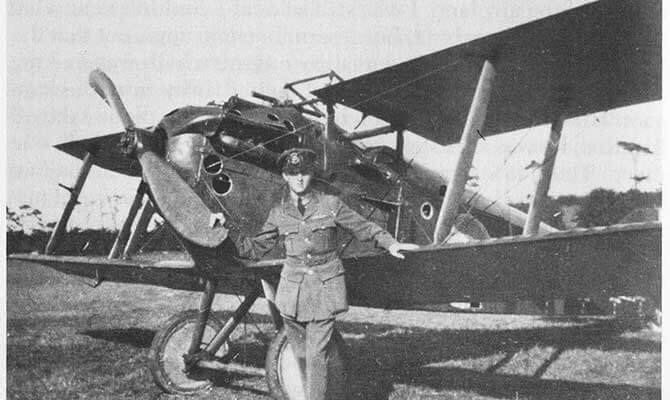Name Cecil Montgomery-Moore | ||
 | ||
Major Cecil Montgomery-Moore DFC was a Bermudian First World War fighter pilot, and commander of the Bermuda Volunteer Engineers and the Bermuda Flying School during the Second World War.
Contents
First World War
At the start of the First World War, Cecil Montgomery-Moore was an enlisted man in the Bermuda Volunteer Rifle Corps. He was given leave to travel to Canada to join the Royal Flying Corps (RFC), air wing of the British Army, one of twenty or so Bermudians who did so during that war. He was one of two Bermudian airmen to earn the Distinguished Flying Cross during the war (the other being Rowe Spurling). In September, 1918, Lieutenant Montgomery-Moore, along with the rest of the RFC and the Royal Naval Air Service (RNAS), became part of the new Royal Air Force.
Between the Wars
Following the First World War, Montgomery-Moore returned to Bermuda. In 1931, the Bermuda Volunteer Engineers (BVE) was created as a replacement for the departed regular Royal Engineers Fortress Company of the Bermuda Garrison (that guarded the Royal Naval Dockyard in Bermuda). The original role of the BVE was to operate the search lights at coastal artillery batteries, notably the Examination Battery at St. David's Head, the guns of which were manned by the Bermuda Militia Artillery (BMA). The BVE subsequently also took on responsibility for providing signals crew and equipment to all elements of the garrison
The first commanding officer of the BVE was Captain H.D. (later Sir Harry) Butterfield, and Lieutenant Montgomery-Moore was second-in-command. In 1932, Butterfield retired, and Montgomery-Moore succeeded him. The new 2-i-c was Lieutenant Bayard Dill (later Sir Bayard), whose father, Colonel Thomas Melville Dill, was a former commander of the BMA.
Second World War
The BVE, like the other part-time units, was mobilised at the start of the Second World War, fulfilling its role to the Garrison throughout the war. Some members also were detached for service overseas with other units. These included four Sappers who were attached to a larger BVRC contingent despatched to the Lincolnshire Regiment in June, 1940, and Captain Richard Gorham, who he served in Italy, playing the decisive role in the Battle of Monte Cassino, earning the Distinguished Flying Cross for this action.
In Bermuda, Montgomery-Moore was promoted to Major in 1940, and Bayard Dill to Captain. In addition to his role with the BVE, Montgomery-Moore also headed the Bermuda Flying School, which trained 80 local volunteers as pilots for the RAF and the Fleet Air Arm. Volunteers were only accepted from those already serving in the local forces, some of whom came from the BVE.
After 1942, with the RAF having a glut of trained pilots, the school converted into the Bermuda Flying Committee, a recruiting arm for the Royal Canadian Air Force, to which it sent sixty aircrew trainees, as well as twenty-two women to train for ground roles. The BFC was administered to by Major Montgomery-Moore, as well as Bertram Work and others prviously associated with the BFS. Major Montgomery-Moore had been dispatched to Canada to make arrangements for it to send its aircrew candidates, and he was to receive a commendation from the RCAF at the end of the war for his efforts.
Post-War
Following the end of the war, the BVE was demobilised in 1946, as were the other three territorials and the Home Guard. The BVRC and the BMA maintained skeleton command structures 'til they began recruiting again in 1951. The BVE, however, with its two main roles becoming obsolete, was disbanded completely.
Major Montgomery-Moore returned to civilian life, eventually resettling in Connecticut, where he died in 1970. Peter Kilduff posthumously published Montgomery-Moore's memoirs as That's My Bloody Plane. His wife, Hélène, gave gifts to Columbia University, in New York, and funded the Mrs. Cecil Montgomery-Moore Scholarship for journalism, in memory of Alice Weel Bigart (the wife of reporter Homer Bigart, who became the first woman to write full-time for a US network news programme, when she joined CBS Douglas Edwards and the News in 1948, and later became Producer of 60 Minutes) before she died of cancer in 1969.
